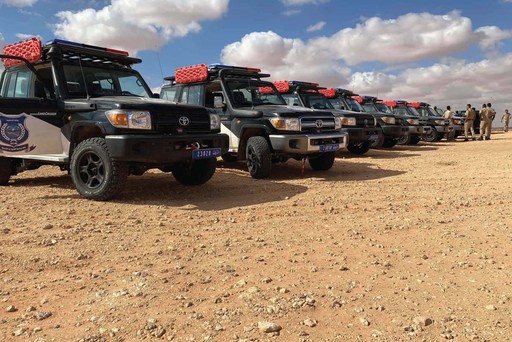Europe has always insisted it does not directly fund detention centers in Libya. It seemed like a cynical semantic game. But how to prove it? For our Aliou Candé investigation, we needed to connect the E.U. funding to its end uses by authorities in Libya.
With some intrepid spadework, we found a treasure trove of information buried in records of E.U. contracts, but it was going to take work to figure out exactly what it added up to. What exactly was paid for, and what did it mean to the operations of Libya’s migrant prisons?
Fortunately, Libyan agencies and militias tend to have their own Facebook pages where images and videos are regularly shared. Even Al Mabani, the notorious center where Candé was killed, has a page. It was possible we could see what the E.U. had helped pay for in action.
It became one of the journalist’s great sports: connecting dots. Sometimes it was straightforward. A video posted to Facebook by Libya’s interior ministry, for example, shows the unveiling of two cutters that were upgraded with E.U. money in Tripoli in the presence of José Sabadell, the E.U. Ambassador to Libya. One of those boats was used to intercept Candé’s boat.
But some dots were harder to connect. For example, through a contract posted on the E.U.’s tenders portal, we discovered that the E.U. had provided 30 Toyota Land Cruisers to Libyan authorities at a cost of €1.75m. But what were the vehicles used for?
Again, we’d have to improvise and scour. The contract was awarded to an Italian company Tekne, which supplies modified Land Cruisers for use in challenging terrains, with a YouTube video on Tekne’s channel showing them in action.
So, the E.U. had sent Libya land cruisers that handle well in challenging terrains. Conveniently, a Facebook post by the Libyan interior ministry shows the vehicles in Libya’s southern desert, where they’re used to intercept migrants crossing into Libya by land.
But there was more. Some striking; some seemingly mundane. All of it, though, essential to the continued workings of Libya’s E.U.-backed system of migrant prisons. The E.U., for instance, had also given buses to Libya. We were able to show how they were used to ferry migrants to detention. A Facebook post by the Department of Combating Illegal Migration shows an Iveco Daily Line minibus, one of 10 provided, transporting migrants to detention.
Over time, we were able to show that from the minute the migrants are brought ashore by the Libyan Coast Guard, E.U. money is used at virtually every step of the way to pay for how they are handled.
It pays for the shipping containers that double as port offices for the Libyan Coast Guard staff, and the touch-screen tablets used by aid personnel who count the migrants as they disembark. It pays for the mattresses where the migrants sleep, as well as the occasional fumigation of these mattresses to rid them of scabies or lice.
The E.U. has committed to purchasing the ambulances that will take migrants to hospital when they get sick. When migrants die, E.U. money helps pay for the body bags and to train Libyan personnel how to handle the corpses in a religiously respectful fashion. Some of these efforts make the prisons more humane, but, taken together, they also help sustain a brutal system, which exists largely because of E.U. policies that send migrants back to Libya.
We didn’t do all this alone. Tineke Strik, a member of the European parliament, has been connecting dots herself and trying to force the E.U. to acknowledge its complicity in a system committing what the U.N. has called “crimes against humanity.” As Strik put it: “If the E.U. did not finance the Libyan Coast Guard and its assets, there would be no interception, and there would be no referral to these horrific detention centers.”

